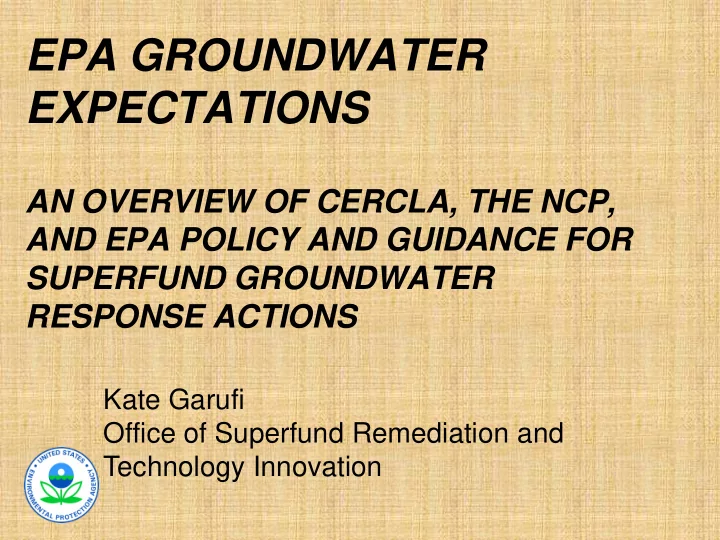

EPA GROUNDWATER EXPECTATIONS AN OVERVIEW OF CERCLA, THE NCP, AND EPA POLICY AND GUIDANCE FOR SUPERFUND GROUNDWATER RESPONSE ACTIONS Kate Garufi Office of Superfund Remediation and Technology Innovation
EPA’s Superfund Program Mission – Defining the End Game Protection of human health and the environment AND Consistent with CERCLA, as implemented by the NCP AND Restore groundwater to beneficial use Groundwater Road Map: Recommended Process for Restoring Contaminated Groundwater at Superfund Sites, OSWER 9283.1-34, July, 2011 1
NCP Expectations for Groundwater Superfund remedies are expected to restore groundwater. The NCP states: “EPA expects to return usable groundwaters to their beneficial uses wherever practicable , within a timeframe that is reasonable given the particular circumstances of the site.” “When restoration of groundwater to beneficial uses is not practicable, EPA expects to prevent further migration of the plume, prevent exposure to the contaminated groundwater, and evaluate further risk reduction.” [40CFR300.430(a)(1)(iii)(F)] 2
Principles of Groundwater Remediation 1. Restore current or potential sources of drinking water. 2. Prevent migration of contaminant plume. 3. Consider TI waiver if statutory criteria are met, when restoration is impracticable. 4. Consider early actions (e.g. source removal, plume containment, alternate water supply). 5. Do not rely solely on ICs. (See 40 CFR 300.430) Summary of Key Existing EPA CERCLA Policies for Groundwater Restoration , OSWER Directive 9283.1-33, June 2009 3
When may a CERCLA remedial action be warranted? A regulatory standard that helps define protectiveness (e.g. a federal or state MCL) is exceeded; or When the estimated risk calculated exceeds a carcinogenic level for an adverse health effect or the upper end of the NCP risk range for “cumulative carcinogenic site risk...”; or The non-carcinogenic hazard index is greater than one; or Site contaminants cause adverse environmental impacts; or Action may be warranted within the risk range given other factors (e.g., sensitive population, high uncertainty, etc.) Summary of Key Existing EPA CERCLA Policies for Groundwater Restoration , OSWER Directive 9283.1-33, June 2009. Role of Baseline Risk Assessment in Superfund Remedy Selection Decisions, OSWER Directive 9355.0-30, April 1991. 4
How does EPA define “Beneficial Use”? Superfund Groundwater Classification and Beneficial Use Policy EPA-endorsed Comprehensive State Ground Water Protection Programs (CSGWPP) EPA will defer to state designations not based on an EPA-endorsed CSWPP, unless it would lead to a less-stringent solution. Summary of Key Existing EPA CERCLA Policies for Groundwater Restoration, OSWER Directive 9283.1-33, June 26, 2009 The Role of CSGWPPs in EPA Remediation Programs , OSWER Directive 9283.1-09, April 1997. Guidelines for Ground-Water Classification Under the [1984] EPA Ground-Water Protection Strategy, Final Draft , EPA/440/6-86- 5 007,November 1986
Remedial Action Cleanup Level Hierarchy for Restoration Remedial Actions ARARs (MCLs or MCLGs) If ARARs are not available or are not sufficiently protective: Carcinogens at a level that represents an excess upper bound lifetime cancer between 10-4 and 10- 6 with10-6 as the point of departure; and Non-carcinogens such that the cumulative risk from exposure will not result in adverse effects to human populations (generally HI • 1) * Level may be lower based on factors such as multiple contaminants, sensitive sub-populations, etc. Summary of Key Existing EPA CERCLA Policies for Groundwater Restoration , OSWER Directive 9283.1-33, June 2009. 6
Alternate Concentration Limits (ACLs) CERCLA Section 121(d)(2)(B)(ii) Standards that are “otherwise applicable for hazardous constituents in groundwater.” • MCLs and WQC would generally not be “applicable” but rather potential “relevant and appropriate” Sets specific requirements. • Known and projected point of entry • No significant increase in constituents • Enforceable measures to preclude human exposure before the point of entry. Use of Alternate Concentration Limits (CLs) in Superfund Cleanups ”, OSWER 9200.4-39,July 19, 200, list factors to be considered. 7
Role of ARAR waivers in Groundwater Restoration Technical impracticability waivers (and other waivers) may be considered, and under appropriate circumstances granted. A waiver decision should be scientifically supported and clearly documented. The TI determination needs to be made on a contaminant- specific basis and on a media-specific basis for cleanup standards Guidance for Evaluating Technical Impracticability of Ground- Water Restoration , OSWER Directive 9234.2-25, September, 1993. Use of Technical Impracticability Waivers at Superfund Sites , OSWER Directive 9230.2-24, August 2012. 8
When are we done? Restoration remedies: the area of attainment/point of compliance for achieving groundwater cleanup levels is generally expected to be throughout the plume or, where there is a waste management area, at the edge of the waste management area. Non-restoration remedies: an alternative remedial strategy has been implemented and documented in a ROD implementation of ICs engineering containment and monitoring in place all groundwater cleanup levels have been met at the point of compliance. 9
QUESTIONS? 10
Recommend
More recommend